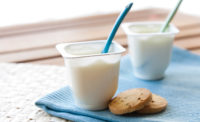In today’s refrigerated grocery store aisles, customers can find a plethora of cultured dairy options — including yogurt/skyr, sour cream, cottage cheese, cream cheese and kefir. From whole-milk Icelandic skyr to low-sugar yogurt to cottage cheese with savory mix-ins, the category certainly isn’t struggling from a lack of innovation. However, according to global market research firm Mintel, it might be too much of a good thing.
“Brands have attempted to compensate for poor performance with increased innovation, ultimately crowding the marketplace and leading to cannibalization as consumers try product after product without increasing total purchases,” notes Mintel in its “Yogurt and Yogurt Drinks US – November 2019” report.
Since peaking in the 2000s with the introduction of Greek yogurt to the U.S. market, American yogurt consumption has gone down. Mintel explains that total sales fell 3.6% between 2018 and 2019 as consumers switched between brands and formats without actually buying more yogurt.
However, while numbers show that Americans eat less yogurt than their European counterparts, Niel Sandfort, senior vice president of new product development and research and development for Chobani, Norwich, N.Y., says the data don’t paint a full picture.
“People on the coasts actually do have the same consumption as European markets, but a lot of households here are not in [the] yogurt category at all,” he notes. “It’s a ‘tale of two cities’ kind of market: Those who think yogurt is for dieting and for women only and those in San Francisco or Brooklyn who think it’s too sweet.”
The trick to growing the category might lie in showing that cultured dairy products can taste great while serving a functional health purpose.
“Consumers are searching for healthy products without compromising on taste, and dairy products are best suited to do so,” says Jorge Ramos, CEO of Dallas-based Lala U.S. Inc.
Showcase functionality
Despite falling sales, the cultured dairy category has reason for optimism. More and more customers are interested in wellness, and cultured dairy already has a health halo.
“As consumers largely turn to yogurt because they feel it is healthy, emphasizing the nutritional benefits offered by each style, type or brand will guide consumers toward the product that best suits their needs,” Mintel says.
But “healthy” means something different today than it did in the past, Ramos says. Customers now look for products with specific functional benefits. Luckily for the cultured dairy category, probiotics are one of the most sought-after nutritional claims.
“Consumer awareness around the benefits that probiotics provide has gained traction, with people understanding that your gut is an essential part of the immune system, and having the right balance of bacteria in your gut is important to maintaining good health,” says Christopher Malnar, vice president of marketing for Londonderry, N.H.-based Stonyfield Organic.
The company recently introduced Stonyfield Organic Daily Probiotics — probiotic yogurt drink shots that come in an easy-to-drink snack-sized format. The shots are available in Blueberry Pomegranate and Strawberry Acai flavors and contain billions of probiotics that help support immunity and digestive health.
“The proactive health segment is driving growth for the yogurt category, growing at a rate of +13% in 2019,” explains Malnar. “Increasing consumer interest in preventive daily healthcare continues to fuel demand for convenient products made with probiotics.”
Pedro Silveira, president, U.S. yogurt, Danone North America — based in White Plains, N.Y., and Broomfield, Colo. — agrees that probiotics continue to be a hot trend. In response, Danone recently added a new product line to its Activia brand: probiotic smoothies. The offerings combine “billions of live and active probiotics with juicy fruit, veggies and seeds, all with zero grams added sugar,” the company says.
The smoothies, which have a suggested retail price of $1.99, are available in three flavors: The Yellow One, which contains flax seeds, mango, carrot, peach and turmeric; The Green One, which has chia, flax and hemp seeds along with pineapple, kiwi, cucumber and ginger; and The Red One, which is made with chia seeds, strawberry, pomegranate, blueberry and beet.
“Activia, which is a leader in probiotics and Danone’s largest global brand, offers several dairy options ... for consumers looking to take care of their gut while getting nutrients from food,” says Silveira.
According to Sandfort, processors should start emphasizing another word when talking about the functional benefits of cultured dairy: fermentation. He’s noticed that with the popularity of kombucha and home brewing, the health value of fermented products is now more widely discussed. However, many consumers still aren’t well informed about what fermentation is.
“We can’t forget that yogurt is one of those ancient fermentations,” he says. “It’s critical that we get the cultured dairy story into the fermentation story, which ends up in this gut health story.”
Less sweet treats
One of the biggest growth areas for cultured dairy is in reduced-sugar products. According to Erin Massey, product development manager for Prairie Farms Dairy, Edwardsville, Ill., when low-fat formulations were popular, processors were forced to add more sugar to create a balanced flavor.
“This new shift in consumer behavior allows us to get ‘back to the basics’ and reawaken and reimagine old favorites,” she says.
According to Silveira, lower-sugar options are the fastest growing segment in yogurt today. Danone North America recently invested in sugar reduction with its Two Good Greek yogurt line. The yogurt is slow-strained with a patent-pending process down to 2 grams of sugar per 5.3-ounce cup. (The product also was the runner-up in the Dairy Foods 2019 Top 10 Best New Dairy Products poll).
Building on Two Good’s success, Danone North America debuted Activia Less Sugar & More Good at the beginning of this year. The line contains only 9 grams of sugar, 40% less than regular Activia Greek nonfat yogurt; its sweetness comes from honey and fruits instead. The yogurt is available in Fig & Cinnamon, Pineapple & Passion Fruit, Pear & Ginger and Blueberry & Cardamom flavors.
And Noosa Yoghurt, a subsidiary of Sovos Brands, Berkeley, Calif., introduced Noosa Hilo yogurt, which has more protein and less sugar than traditional yogurt. According to the company, Noosa Hilo contains 12 grams of protein and 12 grams of sugar per serving. It comes in six flavors, including Vanilla Bean, Blueberry, Mixed Berry, Strawberry, Plain and Peach.
Sandfort says using enzymes to break down lactose is one way to produce cultured dairy that tastes sweeter without actually adding in more sugars; another way is adding sweetness through fruits. And sometimes, customers are just OK with the yogurt tasting less sweet.
“Chobani less sugar yogurt actually is less sweet,” he says. “The consumers adjust their palate.”
Convenience wins
According to Mintel, while sales of spoonable yogurt are dropping, sales of yogurt drinks are on the rise as customers look for grab-and-go versions of healthy snacks. Other recent product innovations in cultured dairy have involved new packaging formats that capitalize on the convenience trend.
“Consumption habits are changing; people are eating more snacks and small meals throughout the day, so retailer sets are evolving to support their needs,” says Lara Gish, category manager, Tillamook County Creamery Association, Tillamook, Ore. “While this is a plus for yogurt, people want variety. This often means shrinking cultured sets with more room for grab-and-go fresh choices like refrigerated bars, cheese snacks and hummus kits.”
Malnar concurs.
“Cultured dairy products that once only came in cups and [were] served with spoons — mainly yogurt — now need to be in formats that can be easily consumed on morning rides to school, packed in lunch boxes or added to coolers at sports games,” he says.
According to Malnar, Stonyfield Organic has released cultured dairy products in pouches, smoothies and shot-like formats to meet evolving consumer needs. The company’s Snack Pack line, for example, pairs organic low-fat yogurt with crunchy dippers such as crackers, cookies or pretzels.
And Prairie Farms introduced new formats of legacy cultured dairy products to appeal to customers looking for convenience.
“Cottage cheese, a legacy product that perfectly aligns with today’s dietary trends, is now available in single-serve containers and in a variety of flavors,” says Massey. “Sour cream is no longer just something spooned from a tub; it is available in squeezable pouches that consumers can pass to their children at the dinner table.”
For its part, Danone is responding to the on-the-go trend by launching more yogurt drinks, including the Activia probiotic smoothies, along with Activia Dailies and Oikos Pro Fuel.
“Oikos Pro Fuel is made with nonfat milk and is rich in nutrients like protein, potassium and calcium, which together help build strong bones and muscles,” says Danone North America. “Each bottle contains caffeine from coffeeberry extract and is equivalent to approximately one cup of coffee.”
And Lala launched a group of drinkable yogurt products, which Ramos says is meant to appeal to its Hispanic base of customers.
“Product design, formulae and flavors have been carefully crafted to meet their specific needs in a way that will connect with them both emotionally and rationally,” he adds.
Dairy doubters
It’s not enough to just produce healthy products, Ramos says. Processors also need to communicate the nutritional benefits of these offerings to consumers. This is especially important with the increasing competition from plant-based alternatives.
“As processors, we are challenged to be more innovative and clearer about the benefits of dairy products so that consumers can easily recognize the nutritional value of them and the superiority [of] some nutritional elements of dairy products when compared to alternative plant-based products,” he notes.
Malnar agrees that it’s important for dairy companies to communicate the nutritious qualities of dairy with customers.
“Organic dairy is one of the best-quality sources of protein,” he says. “Proteins from milk are complete proteins designed to build healthy muscles and bones and satisfy hunger. They are one of nature’s purest and most nutrient-dense foods.”
Some consumers want to eat dairy products, but have the perception that they have digestive issues when doing so. While a small percentage of people actually are lactose-intolerant, Sandfort says upwards of 25-30% believe they are. And it is important to ensure that this customer base feels heard.
“Perception is reality in this time,” he adds.
Ramos concurs.
“We recognize that many consumers have real digestive challenges, so we need to be constantly talking to them to better understand how we can continue to make dairy part of a healthful and tasty diet,” he says.
Silveria says that there also is value to creating products for people who don’t eat dairy — whether due to health issues or dietary choices.
“As the flexitarian lifestyle continues to evolve and gain popularity, companies will need to provide consumers with the choices they need and want,” he explains. “We are a leader in plant-based yogurt alternatives, and we also continue to be the leading yogurt maker in the U.S. We do both by continuing to add value to the category overall and give consumers reasons to keep coming back to the yogurt aisle.”








